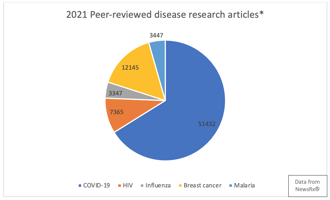It’s now been over three years since COVID-19 began to sweep across the world, altering lives,...
Trends in Research - Best new studies in biomedicine
This is the first article in a new series of groundbreaking trends in research. Stay tuned for updates to the latest research trends in a variety of fields.
Biomedicine continues to expand rapidly as a field. NewsRx’s research database BUTTER identified nearly 17,000 peer-reviewed high-quality biomedical articles, a 37% increase over five years prior.
Biomedicine has seen increasingly streamlined integration of state of the art technologies. These technologies, such as nominal mass spectrometry and capillary electrophoresis, allow for new discoveries in forensic DNA analysis and DNA sequencing, chemical compound identification, and more.
The biomedical field is also facing new challenges. The rise of antimicrobial resistance in bacteria, which kills 700,000 people every year, comes alongside new food and water safety risks such as the per- and polyfluoroalkyls found in consumer products. Not to mention the aftereffects of the COVID-19 pandemic, such as more frequent vaccinations and increased vaccine development pacing.
In 2024, scientists are making discoveries in areas ranging from cell transplantation to precision oncology. Here are five recent, open access studies in biomedicine that have already caught the attention of scientists, or that have exciting potential in the field.
Tracking cardiac disease
Graphene-integrated mesh electronics with converged multifunctionality for tracking multimodal excitation-contraction dynamics in cardiac microtissues - Nature Communications (15). University of Massachusetts and Massachusetts Institute of Technology: Hongyan Gao, Zhien Wang, Feiyu Yang, Xiaoyu Wang, Siqi Wang, Quan Zhang, Xiamoeng Liu, Yubing Sun, Jing Kong, & Jun Yao

Research question and importance
- Cardiac disease is one of the leading causes of death worldwide, and cardiac toxicity currently prevents one-in-three drugs from clinical use.
- Cardiac microtissues are a promising tissue model to model cardiac activity and behavior, but there is no existing tool that is able to track the complex excitation-contraction dynamics that drug development studies must observe.
Methodology
- The researchers developed a mesh bioelectronic system capable of tracking excitation-contraction dynamics.
- The design makes use of a graphene transistor designed to sense the dynamics of cardiac activity.
Results
- Testing confirmed that the system achieves stable tracking and offers assessments for tissue maturation, drug effects, and disease modeling.
- The device can be a tool used in tissue engineering moving forward, with its ability to quantify the dynamic state of cardiac tissue.
Exploring remedies for Parkinson’s
Attenuating mitochondrial dysfunction and morphological disruption with PT320 delays dopamine degeneration in MitoPark mice - Journal of Biomedical Science (31). Taipei National Defense Medical Center, Taipei Tri-General Hospital, Peptron Inc., and elsewhere: Vicki Wang, Kuan-Yin Tseng, Tung-Tai Kuo, Eagle Yi-Kung Huang, Kuo-Lun Lan, Zi-Rong Chen, Kuo-Hsing Ma, Nigel H. Greig, Jin Jung, Ho-Il Choi, Lars Olson, Barry J. Hoffer, & Yuan-Hao Cheng

Research question and importance
- Parkinson’s Disease (PD) is the second most common neurodegenerative disorder, and recent research has shown that mitochondrial disfunction is a key part of the disease.
- Glucagon-like peptide-1 receptor (GLP-1R) has effectively treated type 2 diabetes for many years. The agonist has been brought forth as a potential tool for addressing mitochondrial dysfunction in the case of PD. But what are the agonist’s exact effects on mitochondria?
Methodology
- Researchers treated a progressive PD mouse model, the MitoPark mouse, with a sustained release formulation of GLP-1R known as PT320.
Results
- The PT320 chemical compound may be clinically effective in treating PD.
- The treatment significantly preserved mitochondrial function and morphology, although it did not change the reduction in mitochondria numbers that is accompanied by PD.
- These results demonstrate the importance of preserving mitochondrial morphology when faced with neurodegenerative disfunction.
Developing decolonized medicine
Rapid ethnographic appraisal of community concepts of and responses to joint pain in Kilimanjaro, Tanzania - BMJ Global Health 9-1. Kilimanjaro Clinical Research institute, Kilimanjaro Christian Medical University, University of Glasgow: Elizabeth F Msoka, Christophre Bunn, Perry Msoka, Nateiya M Yongolo, Emma Laurie, Sally Wyke, Emma McIntosh, Blandina T Mbaga.
Research question and importance
- The strict imposition of ‘western’ biomedicine by doctors has led to unintended negative consequences when attempting to solve global health crises in African communities. Authors propose a medical anthropology approach that understands local and everyday approaches to illness.
- So what would a a “decolonized” approach to global health look like in the area of joint pain in Kilimanjaro, Tanzania?
Methodology
- For the case of joint pain in the Hai district of Tanzania, authors utilized a rapid ethnographic appraisal (REA) to characterize responses to joint pain, determining the dominant concepts of joint pain and treatments.
Results
- Authors describe the unique mix of folk and biomedical practices in the region, avoiding biomedical categorization.
- The described approach offers clinicians in northern Tanzania knowledge of how patients talk about and understand joint pain, promoting more effective and tailored treatment.
Marking the boundaries of melanoma
Double Immunohistochemical Labelling of PRAME and Melan A in Slow Mohs Biopsy Margin Assessment of Lentigo Maligna and Lentigo Maligna Melanoma - British Journal of Biomedical Science, 19. St. John’s Histopathology Department: R. Salih, F. Ismail, & G.E. Orchard.

Research question and importance
- Lengo maligna is a slow-growing subtype of melanoma that occurs often on the heads and necks of elderly patients. However, surgical removal is very difficult, as the lesions tend to have unclear borders. So a key step in the process of surgical removal is the use of melanocytic markers to detect and visualize melanocytes in the skin through different labeling patterns.
- One potential tool for this is Preferentially expressed Antigen in MElanoma (PRAME). But just how effective is PRAME in assessing melanoma’s margins?
Methodology
- This study used 51 samples to compare the sensitivity of PRAME double-labeling in lengo maligna biopsies to the established single-labeling technique.
Results
- 96.1% of the samples agreed.
- Double-labeling is a viable alternative or additional assessment strategy in the difficult task of lengo maligna biopsies.
Using GPT for biomedicine
Advancing entity recognition in biomedicine via instruction tuning of large language models - Bioinformatics, 40. Yale University, University of Texas, National Library of Medicine: Vipina K Keloth, Yan Hu, Qianqian Xie, Xueqing Peng, Yan Wang, Andrew Zheng, Malih Selek, Kalpana Raja, Chih Hsuan Wei, Qia Jin, Zhiyong Lu, Qingyu Chen, Hua Xu.
Research question and importance
- There are specific machine learning models that can scale biomedical texts to find entities such as genes or diseases. However, these can rarely be utilized outside of the task they are trained for, lacking flexibility compared to large language models (LLMs) such as GPT-4.
- Researchers sought to challenge the assumption that LLMs are not proficient at named-entity recognition (NER), or locating and classifying certain targets in a set of unstructured text.
Methodology
- Authors developed a new learning paradigm that enables LLMs to perform NER tasks for biomedical texts.
- The new learning paradigm made use of an instruction-following model and played into LLMs’ strengths: text generation and reasoning.
Results
- The resulting LLM-based model outperformed PubMedBERT and PMC-LLaMA on disease categorization, and performed comparably on chemical and gene categorization.
- The approach described in the study can be used to transform existing datasets into instruction samples for LLMs in different fields.

.jpg?width=50&name=DSC_0028%20(1).jpg)


